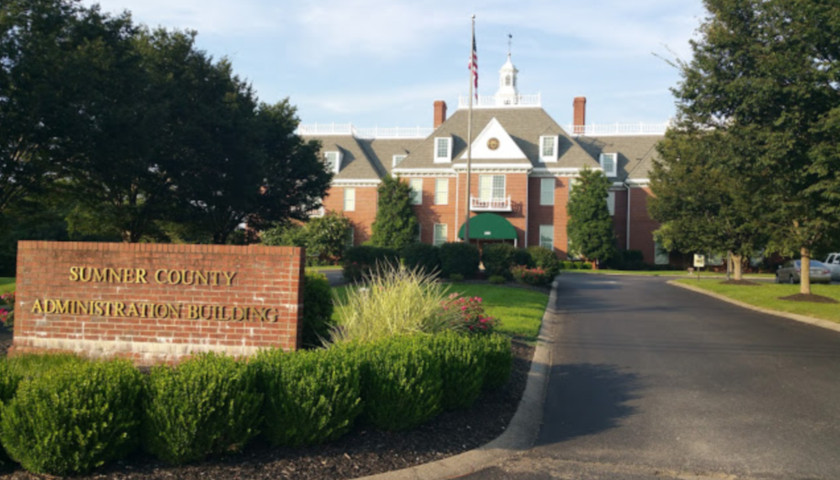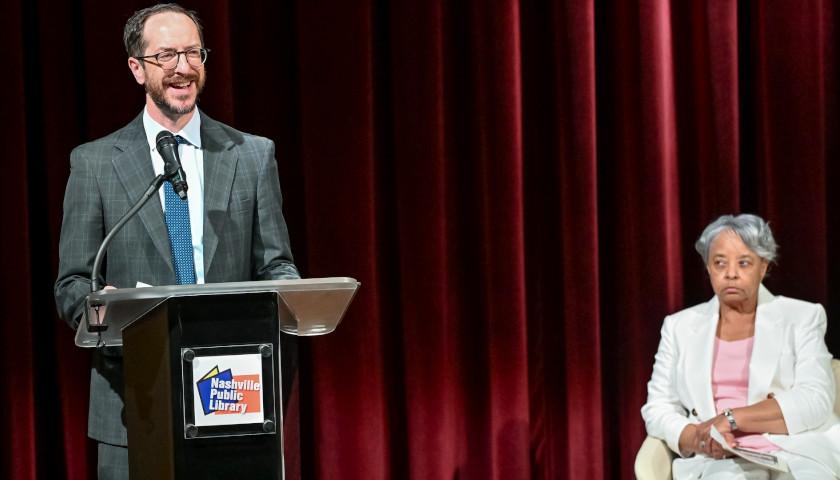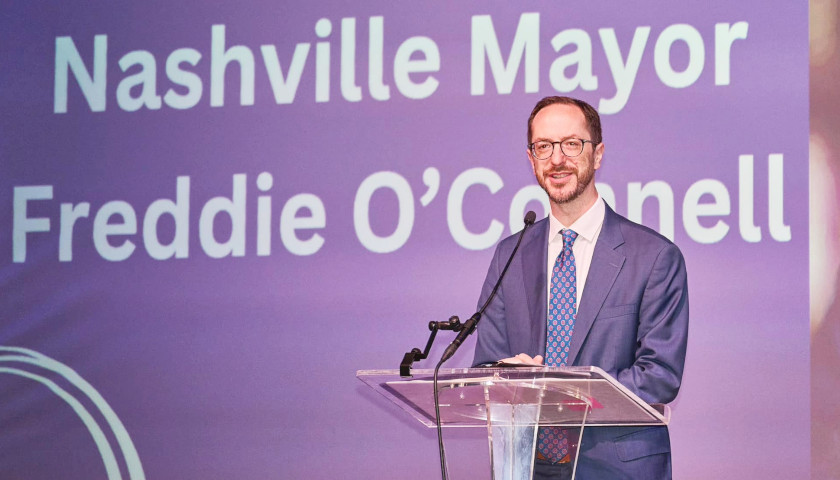GALLATIN, Tennessee – At the regularly scheduled October meeting of the Sumner County Board of Commissioners held Monday, the $96.7 million Phase I plan for the courthouse project was approved by a vote of 20-4.
The only appropriations for the project approved at the same meeting was $6.7 million. Additional votes will be needed to fund the balance of the project, which, after the $5.7 million already appropriated earlier this year, remains in excess of $84 million.
The Phase I plan was presented by Mike Thomas, president of Justice Planning Associates, Inc. (JPA) a South Carolina firm that specializes in justice system planning, which was selected by Sumner County in 2017.
[pdf-embedder url=”https://tennesseestar.com/wp-content/uploads/2019/10/JPA-Presentation-Phase-I-10-21-19.pdf” title=”JPA Presentation Phase I 10-21-19″]
The move to use a judicial planner came as a result of repairs recommended by County Mayor Anthony Holt, particularly related to the historic courthouse on the Gallatin square, that were continually brought to the Commission’s General Operations Committee.
In May 2018, JPA presented a report of the findings of their review and rating of the current facilities as well as project recommendations to the Sumner County Commissioners.
The first phase of the May 2018 project plan called for consolidating the courts located in the current criminal justice center, the historic courthouse and the juvenile court along with the clerks of court into a single courthouse on the square.
In addition, there was to be a short-term jail expansion of approximately 48 beds to accommodate overcrowded incarcerated females.
In 2018, the total cost of the first phase for the new courthouse and jail expansion was estimated at $80,454,992.
A second phase of the project in the 2018 plan was to include the renovation of the historic courthouse on the square to accommodate the district attorney’s office, an expansion of the sheriff’s office into the former courtroom space and an expansion of the jail into the former sheriff’s office space within the current criminal justice center.
The second phase of the project had an estimated cost of $18 million.
In May 2018, JPA’s plan for the combined first and second phases, along with a contingency budget of $3,451,952, totaled $102,079,143. That plan did not include a parking garage – an element that has been said the City of Gallatin desperately needs and comes with a price tag of about $20,000 per parking space, not including the land acquisition.
There was no approval of JPA’s plan or funding for the May 2018 plan at the time.
During various county meetings after JPA’s May 2018 presentation, there were references to ad hoc committee meetings held about the courthouse plan, although no public meeting notices were issued and when records of those meetings were requested, the response was that no one from the County Clerk’s office had been asked to record minutes for the meetings.
Meanwhile, various pieces of the courthouse project plan were being executed, that became clear only with JPA’s October 2019 presentation.
For example, in July 2018, the Sumner County Commission approved $202,500 for the purchase of a gravel parking lot owned by the First Baptist Church of Gallatin located across South Water Street from the current judicial center.
The county later paved, marked, added curbing and run-off retention ponds to the lot. The cost of the improvements to the lot beyond the $202,500 purchase cost was not documented in any of the minutes of the ensuing General Operations Committee meetings.
This is the very same lot that the then-Budget Committee politely refused County Mayor Holt’s efforts to have paved on behalf of the church, due to usage associated with the judicial center, back in October 2016.
In JPA’s October 2019 plan, the now-improved lot is slated to be used as a “lay down” area for the courthouse construction materials. It is not clear if using the paved lot as a lay down area will cause any damage to it, but it will presumably make the lot unusable during the multi-year construction of the new courthouse.
Another piece of the yet-to-be-approved plan was moved forward in March 2019, when the Sumner County Commission approved the purchase of a building also from the First Baptist Church of Gallatin for $865,000 to allow the placement of the new courthouse on JPA’s recommended site adjacent to the Gallatin Library.
While initially billed as a “swap” of two of Sumner County’s facilities – the juvenile courthouse and probation buildings – in exchange for the church’s youth ministry building, the county ended up agreeing to pay $865,000 for the church’s building.
In addition to the $865,000 for the Church’s building, Sumner County will also pay an estimated $125,000 to demolish the county probation building, plus $577,500 to up-fit space to be leased until the courthouse is completed and an estimated $584,220 in lease costs for the three-year construction period, according to JPA’s Phase I plan.
While an “alternative site #2” was included in JPA’s 2018 report, neither it nor any other site within the county was considered or evaluated for total cost, the firm’s President confirmed at a previous County Commission meeting.
The October 2019 presentation by JPA’s President Mike Thomas at the county commission meeting included a review of the projected growth of the county and the status of the current facilities followed by estimated costs updated with new related projects and expenses.
JPA’s presentation showed Phase I of the courthouse project totaling $91,009,913. However, it deducted the $5,700,000 previously approved expenses, making the actual Phase I total $96,709,913.
Phase I included $11,252,470 of “new related projects and expenses,” as follows:
Project Management/Construction Management through 2022 – $500,000
Transition for Juvenile Court and County Probation
- Security Deposit – $15,750
- Up-fit (21,000 sq. ft. x $27.50) – $577,500
- Lease Costs – Year 1 (2020) (21,000 sq. ft. x $9.00) – $189,000
- Year 2 (2021) (21,000 sq. ft. x $9.27) – $194,670
- Year 3 (2022) (21,000 sq. ft. x $9.55) – $200,500
- County Probation Building Demolition – $125,000
Parking Garage
- Design Fees – $450,000
- Construction 450 spaces x $20,000 – $9,000,000
The jail housing pod addition at $5,000,000 was a significant increase over the May 2018 estimate of $2,000,000, but was not included as part of the “new related projects and expenses” section of the presentation.
While not included in the presentation, Phase II of the project was later discussed.
A goal for Phase II of JPA’s plan is to “save the courthouse,” – the name of a citizen-led movement – which will calls for the history structure to be renovated and used for the district attorney general’s office after it is vacated when its current occupants move into the new courthouse.
Phase II will also include an expansion of the sheriff’s office into the courtrooms of the current judicial center and then an expansion of the jail into the current sheriff’s office.
Budgetary numbers in May 2018 for Phase II were $18 million, but would be more like $20 million according to JPA’s Thomas because of the time that has passed.
Upon completion of JPA’s presentation, the floor was then opened up for public comments.
Speaking in favor of the proposed project were:
- Jay Ingrum, attorney with Phillips & Ingrum located on the square in downtown Gallatin, bar association member of the courthouse project advisory group and owner of one of the pieces of property where the new parking garage is to be located.
- Mark Smith, Clerk and Master for Chancery Court of the 18th Judicial District
- Shawn Fennell, City of Gallatin, Council at Large and member of the courthouse project advisory group and the parking garage ad hoc committee formed by County Commissioner and General Operations Committee Chair Leslie Schell
- Russ Edwards, attorney with Edwards & Edwards and Alderman of the City of Hendersonville
- Jimmy Overton, City of Gallatin Councilman and member of the parking garage ad hoc committee formed by County Commissioner and General Operations Committee Chair Leslie Schell
- Kathryn Strong, Sumner County Circuit Court Clerk
Citizen Ruth Fennell said she found herself “once again” asking the commissioners to “do the right thing” by taking care of the taxpayers who are funding all of this and that she would be pleasantly surprised if they actually did.
As with the recent property tax increase of 17 percent, Mrs. Fennel said the debt that the county commission would undertake for this project – piling up to $500 million with this and other future projects – is “enslaving the very children that you’re using as the justification for these tax increases.”
She reminded the commissioners that just a few years ago there was a resolution to be debt-free, but the county could not be debt-free with the “spending spree” it is currently on.
Initiating the approval process of JPA’s plan, Chair of the General Operations Committee and spearhead of the courthouse project, Leslie Schell, introduced the resolution to adopt JPA’s Phase I plan saying that “we recognize the courage and devotion of our SRO’s (School Resource Officers), our sheriff’s department, our judges, our judicial employees. They have made do with too little for way too long.”
Commissioner Schell concluded, “We have an opportunity here tonight to leave a legacy behind us with this building and this judicial center and a building that will reflect their excellence.”
When discussion was taken up by the commissioners, Commissioner Moe Taylor said that only one location was ever pursued, and that there were reasons and benefits to that, despite the fact that there is county-owned property that would have made the project economically more feasible.
Commissioner Moe Taylor said that the citizens he had heard from did not want their taxes increased, and he, therefore, would have to vote against the plan that would then lead to the associated spending to execute the plan.
Budget Committee Chair Chris Taylor asserted that if they kept to the original construction start of 2021 or 2022 and not accelerated the plan for the parking garage, moving the juvenile court and the jail modules, the debt capacity would have been there.
As The Tennessee Star reported, the fiscal year 2020 budget included a $0.33 property tax increase approved by a 17-7 vote of the county commission, of which $0.04 was earmarked to move up the timing on the jail pods, relocation of the juvenile court and the parking garage to this year.
The City of Gallatin’s need for a parking garage drove the city to delay their own bond issuance, in hopes of partnering with the county on the cost of the garage. However, Gallatin reportedly also needed the county to commit to the garage at the early stages of the courthouse project, not at the end as originally planned.
Commissioner Jeremy Mansfield inquired as to the portion that the City of Gallatin is going to contribute toward the parking garage, since they are requesting that the timeline for it be moved up.
Commissioner Chris Taylor said that, while the rough idea of the cost per parking spot is known, hard numbers are not yet available. Once the money is spent on the architect to determine the size and how many parking spaces, JPA will then negotiate with Gallatin to determine how much access to it to they want compared to how much they are willing to pay.
Commissioner Chris Taylor confirmed Commissioner Mansfield’s information that Gallatin had originally said $3 to $4 million. The cost they were thinking about at that time, Commissioner Chris Taylor said, was about $7 or 8 million, so it would have been about half of the total cost Gallatin had talked about contributing.
Commissioner Chris Taylor went on to say that now the cost is more like $10 or $11 million, “and we hope it’s not much more than that by the time we actually start building it.” It will depend on Gallatin’s bond capacity, said Taylor, “and I wouldn’t even think of speaking to that.”
Commissioner Steve Graves asked why the property owners where the parking garage is to be located wouldn’t be approached prior to approving the plan, in case there was an issue in obtaining the property.
Chairman Scott Langford said he didn’t know if that could be answered that night.
“My guess, and it’s just speculation on my part, Law Director correct me if I’m wrong, I believe the property that we’re looking at is owned by the businesses there. So, I think what Mike (JPA President) was suggesting is that they’re probably going to want covered, lit, secured parking in a garage designated for their business as opposed to outside in the elements, but we really can’t speculate on that.”
“But I also don’t think that a business owner is going to enter into any kind of a negotiation until they know there’s a plan,” concluded Chairman Langford.
JPA’s Thomas offered an analogy about the very complicated project, with a lot of moving parts, which is like eating an elephant – one bite at a time.
He added that JPA has delivered every step of the way, and mentioned the negotiation with the First Baptist Church of Gallatin as one of the accomplishments.
Unlike the apparent condition put on the negotiation related to the parking garage, the negotiation or the Church property, completed earlier in the year, was done prior to the approval of the courthouse plan.
Commissioner Schell added that there are only a couple of property owners, one of whom is Mr. Ingrum’s father, the first up during public comments that night speaking in favor of the project. The younger Mr. Ingrum, as Commissioner Schell pointed out, also sits on the planning advisory committee with JPA, “so that he is very familiar with the plans of this.”
“Those property owners are just as excited about this project as anybody is, because it’s revitalizing that downtown,” added Commissioner Schell, although she said that there has not been a formal conversation with them yet.
“Anybody that owns a business in downtown Gallatin, I can assure you,” Commissioner Schell said breaking out in a smile, “is very familiar and in support of this project, because it is going to revitalize.”
Saying that the additional input didn’t really answer his question, for nearly five minutes, Commissioner Graves had a running debate with Chairman Langford, during which Commissioner Graves’ concerns about taking people’s property – alluding to the very recent situation where land was taken by eminent domain from property owners so that a sewer line for the new Liberty Creek school campus could be constructed by White House Utility District – went unanswered and unaddressed.
Also, Commissioner Graves’ request during the debate for the total cost of the project and the City of Gallatin’s contribution to it went unanswered by Chairman Langford.
When County Mayor Holt was recognized to speak, he said he had just spoken with Mr. Ingrum, who is willing to negotiate in good faith.
Holt added, “Let’s be honest, we’re making an $80 million investment in downtown. These are business people, they understand that kind of investment is going to have a direct impact on the value of their property. It’s going to increase the value of their property.”
Holt went on to dispute the amount of debt saying it was only $233 million – “a long way from $500 million.”
However, a table dated August 2019 prepared by Sumner County’s Director of Finance, David Lawing, who reports to Holt, shows that the county’s current debt of $224 million plus interest of $70 million totals $294 million of debt.
The $294 million of debt is before the courthouse project – which will total $110 to $115 million between Phase I and Phase II, and before the second phase of the Liberty Creek complex, and does not include the tens of millions of dollars in associated interest.
Of the historic courthouse built in 1939, Holt went on to say that as County Mayor – a position he has held for more than 10 years – he is responsible for the maintenance, and “it’s a wreck.”
Commissioner Baker Ring said that he has heard people oppose this, but not offer an alternative.
Not mentioned was that offering multiple options was one of the supposed objectives and benefits of hiring a judicial planner to assist in the planning process, although no alternate plans were ever offered by JPA.
Commissioner Ring went on to say that working with youth mock trials, students have commented on the condition of Sumner County’s courthouse and how bad it is, comparing it to the Montgomery County courthouse in Clarksville, “which is an amazing building.”
Commissioner Ring, a Gallatin High School government and economics teacher, didn’t indicate if his students were aware that, if they continue to be county residents, they will bear the costs over the next 20 years for any debt issued for the new Sumner County courthouse that is “very reminiscent of the Montgomery County courthouse” which will also “be an amazing building,” according to Commissioner Ring.
“I believe we have no alternative but to vote for this,” concluded Commissioner Ring.
Commissioner Mansfield, in speaking again, alluded to JPA’s May 2018 plan which stated with regard to their space projections for staff areas, “In many cases, the overall quantity of space would be considered fairly sufficient if it could be reconfigured and re-purposed.”
A recurring theme of “convenience” came from the speakers, said Commissioner Mansfield, and he had to consider convenience for taxpayers. He was told back in March in response to his questioning that this would not trigger a tax increase, yet it did.
Commissioner Mansfield went on to say that he and the citizens who have reached out to him have a problem with it when “we say we don’t have to raise taxes, and we’ve already done it.”
Commissioner Chris Taylor called a point of order, taking issue when Commissioner Mansfield said that taxes were raised to increase debt capacity.
When Commissioner Mansfield went on to point out that the $103 million in school bonds came after JPA’s initial presentation, Chairman Langford, who also serves as the Sumner County Schools Director of Instruction, shut down Commissioner Mansfield saying that the school bonds “have nothing to do with it” and instructed Commissioner Mansfield to “move on.”
When Commissioner Mansfield continued that the tax increase is for the court system, Chairman Langford once again called him out of order.
Commissioner Mansfield concluded that not being considered are other things – beyond their control – that are happening in Sumner County that could easily necessitate a tax increase. Rushing the timeline, said Commissioner Mansfield, caused an increase in taxes.
To Commissioner Mansfield’s point, the two drivers of the accelerated timeline – overcrowding of the jail and Gallatin’s push for the parking garage – were both caused by things beyond the commission’s control.
When Commissioner Mansfield concluded his remarks and with no one else in the queue, Chairman Langford called for the vote, resulting in 20 Yes and 4 No votes.
The four commissioners voting against the plan were Steve Graves, Merrol Hyde, Jeremy Mansfield and Moe Taylor.
The commission later voted to appropriate $6.7 million, $3.5 million of which was transferred from the capital projects fund, to pay for the costs to be incurred this year for the jail pods, relocation of the juvenile court and the parking garage.
The resolution for the $6.7 million appropriation ended in the same 20 to 4 vote, with the same four commissioners voting against the measure.
The video of the October 21, 2019, meeting of the Sumner County Board of Commissioners can be watched here.
– – –
Laura Baigert is a senior reporter at The Tennessee Star.






I emailed a note to my two commissioners thanking them for spending Sumner County into oblivion. I have not yet received my new and much increase property tax statement and they are already piling on more outrageous debt.